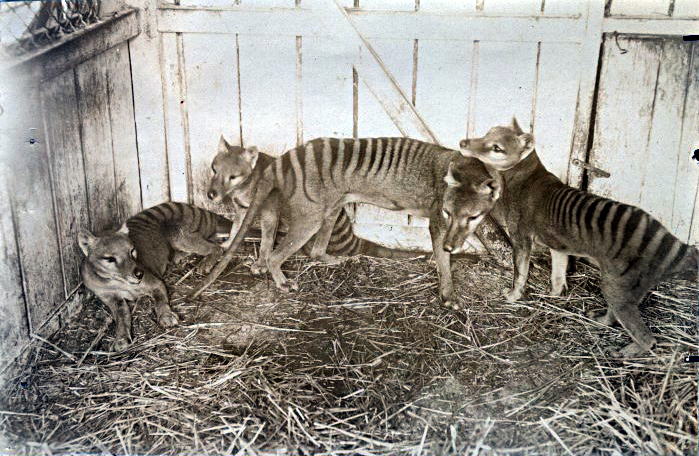
Thylacine Skeleton – Tasmanian Tiger
This Thylacine Skeleton represents an animal species that became extinct in 1936.
The Thylacine (Greek for “dog-headed, pouched-one”) was the largest known carnivorous marsupial of modern times.
It was the last surviving member of its family. It is commonly known as the Tasmanian Tiger because of its striped lower back.
The Thylacine was a shy, nocturnal creäture with the general appearance of a medium-sized dog, except for its stiff tail and abdominal pouch/.
The Thylacine’s looks were reminiscent of a kangaroo, but it also had dark transverse stripes that radiated from the top of its back, similar to those of a tiger.
The Thylacine had become extinct on the Australian mainland 2,000 years ago, but it survived on the island of Tasmania, until 83 years ago. Intensive hunting encouraged by government bounties is blamed for its extinction.
From 1886 to 1909, the Tasmanian Government paid one pound for every Thylacine killed.
A sharp drop in bounty payments between 1908 and 1909 suggests that the Thylacine suffered from some widespread disease.
They were not declared “protected” until 1936, just before the last one died in captivity in 59 days later.

Thylacines at the Beaumaris Zoo in Hobart, 1910
Tasmanian Tiger – Animal Facts
- In 1936, Tasmania’s Government officially listed the Tasmanian Tiger as a protected species, unfortunately too many years too late, as 59 days later, the last known Tasmanian Tiger died.
- Multiple factors led to the eventual extinction of the Tasmanian Tiger, including competition with wild dogs introduced by European settlers, erosion of its habitat, the concurrent extinction of prey species, and disease that affected most of the captive specimens at the time.
- The Tasmanian Tiger like Bigfoot and the Loch Ness monster has had thousands of unconfirmed reported sightings since it was declared extinct.
- The Thylacine was nicknamed the “Tasmanian tiger” or the “Tasmanian wolf” because it shared a surprising number of features of these two combinations of animals. However, the Thylacine was a marsupial and only distantly related to cats and dogs. These carnivores evolved independently, but with similar features, this phenomenon of near-identical traits appearing in two unrelated organisms is known as “convergent evolution.”
- The Tasmanian Tiger predominantly hunted at night, and their prey included kangaroos, small mammals, and birds. Research on thylacine skeletons suggests that they evolved as ambush predators.
Thylacine Skeleton (Tasmanian Tiger)
- Title: Thylacine Skeleton
- Dates: 1920s
- Date of Extinction: 1936
- Museum: National Museum of Australia
New footage of a Tasmanian Tiger has been discovered.
The Tragic Tale of the Tasmanian Tiger
Explore the National Museum of Australia
- Platypus Nest
- Thylacine Skeleton (Tasmanian Tiger)
- Mummified Thylacine Head
- Aboriginal King Plate of Billie Hippie
- Convict Leave Pass
- Ptolemy’s View of the Solar System
- Cannon from the Endeavour
Explore Natural History Museums
- Natural History Museum, London
- American Museum of Natural History, New York
- National Museum of Natural History, Washington, D.C.
- Shanghai Natural History Museum
- National Museum of Nature and Science, Tokyo
Explore Aboriginal Artifacts and Stories
- Australian Museums
- Coolamons and Aboriginal Carrying Vessels
- Aboriginal Shields
- Australian Aboriginal Shields
- Woureddy, an Aboriginal Chief of Van Diemen’s Land
- Trucaninny, wife of Woureddy
- Aboriginal Message Stick
- Platypus Nest
- Thylacine Skeleton (Tasmanian Tiger)
- Mummified Thylacine Head
- Aboriginal King Plate of Billie Hippie
- Australian Aboriginal Sayings and Quotes
- Bedgi-Bedgi
- Australian Native Police Uniform
- A Book of Drawings by Tommy McRae
- “View taken from the spot – Bateman’s Hill” by George Alexander Gilbert
Thylacine
Last Tasmanian Tiger 1933
~~~
“The more you know, the less you need.”
-Australian Aboriginal saying
~~~
Photo Credit:GM2) See page for author [Public domain], via Wikimedia Commons 3) By Unknown – http://www.naa.gov.au/whats-on/online/pic-of-the-week/pow_36_enlargement.aspx, Public Domain, Link
Top Posts & Pages








 Sponsor your Favorite Page
Sponsor your Favorite Page SEARCH Search for: Search Follow UsJoin – The JOM Membership Program
Become a Patron!
Sponsor a Masterpiece with YOUR NAME CHOICE for $5
Share this:
- Tweet
